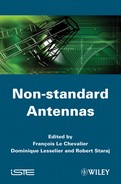Table of Contents
Chapter 1. Joint Diversity and Beamforming for Downlink Communications
1.2. Space diversity versus beamforming
1.4. Beamforming by SNR maximization
1.5. Combining transmit diversity and beamforming
1.6. Minimum variance criterion
Chapter 2. Acoustic Antennas for Biomedical and Industrial Ultrasonic Imaging
2.2. Basic ultrasonic transducers
2.4. Piezoelectric material issues
2.5. Modeling, design and characterization of ultrasonic antennas
2.6. High frequency (HF) acoustic antennas for biomedical microscanning applications
2.7. New acoustic antennas based on technology of capacitive micromachined ultrasonic transducers
Chapter 3. Space-time Exploration for Airborne Radars
3.2. Colored space-time exploration
Chapter 4. Multifunction Antenna System Concepts: Opportunity for Ultra-wideband Radars?
4.1. Multifunction radio frequency (RF) systems
4.2. Multifunction RF systems and Ultra-Wideband (UWB) radars
Chapter 5. From a Molecule to an Electro-optic Antenna
5.2. Synthesis of the electro-optic polymer
5.4. Device fabrication and poling
Chapter 6. Terahertz Broadband Micro-antennas for Continuous Wave Imaging
6.2. UWB THz antennas for superconducting hot electron bolometers
6.3. High-impedance THz antennas for semiconducting bolometers
Chapter 7. Dual Frequency Millimeter Feed
7.3. Technology and first design
7.4. Optimization and final design
7.5. The whole antenna: horn + reflector
7.6. Comparison to measurements
Chapter 8. Reconfigurable Printed Antennas
8.3. Active components used for reconfiguration
8.4. Printed antennas and compact antennas
8.5. Frequency reconfigurable antennas
8.6. Radiation pattern reconfiguration
8.7. Polarization agile antennas
Chapter 9. Wideband Antennas and Artificial Magnetic Conductors
9.2. Wideband antenna and metamaterial
9.3. How to characterize an artificial magnetic conductor?
9.4. Narrow bandwidth antenna above an AMC
9.5. Wideband antenna placed above an AMC
9.6. Very wideband antenna placed above an AMC
Chapter 10. High Impedance Surface Close to a Radiating Dipole
10.3. Analysis of the phenomena
10.4. Phenomenological model of the radiating array
PART 3. DETECTION/LOCALIZATION
Chapter 11. Advanced Processing for DOA Estimation
11.2. Observation model, problem formulation and standard MUSIC method
11.3. Non-selective advanced DOA estimation techniques
11.4. Selective advanced DOA estimation methods
Chapter 12. Multifunction Airborne Antennas
12.2. Functions performed by the principal sensors of a fighter aircraft
12.3. Technique of active antennas
Chapter 13. Active Sonar: Port/Starboard Discrimination on Very Low Frequency Triplet Arrays
13.2. Port/starboard beamforming on a triplet array
13.3. Adaptive beamforming on a triplet array for reverberation reduction
Chapter 14. Airborne High Precision Location of Radiating Sources
14.3. Description of lab experiment
Chapter 15. Ground-based Deformable Antennas
15.2. Impact of antenna distortions on radar systems
15.3. Instrumentation of deformable antennas
15.4. Compensation with knowledge of the antenna shape
15.5. Experimentation on a deformable antenna mock-up
Chapter 16. Automatic Take-off and Landing System
16.3. MAGIC ATOLS main features
16.5. MAGIC ATOLS processing for low elevation measurement
16.6. On the field experimental results
Chapter 17. Anti-jamming for Satellite Navigation
17.1. Satellite navigation principles
17.2. Vulnerability of the GNSS signals
17.5. Antenna and associated electronics integration
17.6. New functions associated with the antenna array
Chapter 18. Ultra-wideband Antenna Systems
18.2. The principles implemented through two applications
18.3. The ultra-wideband antennas
18.5. Pulse antenna systems in high power microwaves
Chapter 19. Co-design of the Antenna with LNA for Ultra-wideband Applications
19.1. The interest in co-design
19.5. Protocols and measurement results
20.2. Deterministic channel model based on ray tracing
20.3. Antenna vector function description via VSH
20.4. Immediate RT tool application
